Article and all photos by Joe Mock, BaseballParks.com
All rights reserved
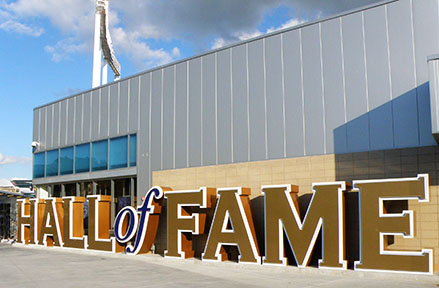 |
Head of the class
Many big-league teams have honored their history with exhibit areas within their ballparks, often with banners or statues of spectacular players or timelines of milestone events. Several have established stand-alone halls of fame, often fashioning them as museums of the history of the team or of baseball in that city. Noteworthy examples of this kind of permanent exhibit space include the Braves, Rangers, Cardinals, Reds and of course Yankees … with the separate two-story building in Cincinnati being the most impressive of them all.
None have done it better, though, than the Kansas City Royals, who debuted their 7,000-square-foot masterpiece on July 16, 2009. Truly, they now join the Reds at the head of the class in baseball museums that are specific to a team or city.
The two-level building in which the new Royals Hall of Fame (the team abbreviates it “RHOF,” so I will, too) is housed was part of the $250-million renovation that Kauffman Stadium received in 2008 and 2009, most of which was completed prior to the beginning of the 2009 season. I chronicled those massive (and remarkable) changes in a photo essay in April, 2009. The RHOF, part of the “Outfield Experience” that was created during the renovation, wasn’t ready by the start of the season.
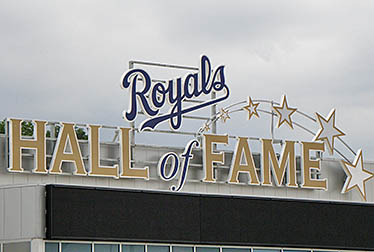 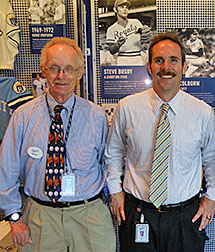 |
I was fortunate enough to be invited to the grand opening. The wonderful Morrie Carlson (shown on the left side of the righthand photo above), who oversees the guided tours given to visitors to Kauffman Stadium throughout the year, was kind enough to give me a special behind-the-scenes look at the facility before the public was allowed to view the place. Many thanks to him for taking the time to allow me — and my camera — to check out the impressive place before it was jammed with fans.
Also, there’s further need to give credit where credit is due. The mustachioed gentleman next to Morrie above is Curt Nelson. He’s the Royals’ front-office employee whose job is akin to an obstetrician: he was to oversee the birth of the new RHOF. And it was a tireless endeavor indeed, and he deserves a great deal of credit for the shiny new facility.
And perhaps the biggest surprise of all to me was who designed the Royals Hall Of Fame. I assumed it was done by folks from Cooperstown, or by museum experts from the Smithsonian. Nope! Populous (formerly known as HOK, the architects behind all of the renovations at Kauffman) designed the building and figured out the particulars on the exhibits. And they did an extremely impressive job.
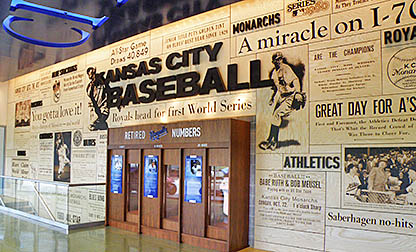 |
By no means is this photo essay meant to show you all of the exhibits in the new facility. Rather, it gives you a look at some of my favorites while (I hope) enticing you to book a trip to Kansas City to see it for yourself. Remember, you aren’t limited to the baseball season to get to see it. The Royals have a vibrant tour operation year-round, and the Hall Of Fame is now part of their wonderful guided tour. Click here for info on their tours and here for what the Royals have to say about their new Hall of Fame.
So let’s start with a look at the Clubhouse Lobby (above), which is the first aspect of the RHOF you’ll encounter when you enter from the concourse outside. The wall you see is actually made of wood — ash, to be exact — on which you’ll see actual headlines about the various teams that have called KC home. Those teams include the Blues, a Minor League franchise that spanned half a century starting in the late 1800s, the Monarchs of the Negro Leagues, the Athletics in between their stays in Philadelphia and Oakland and the modern-day Royals, an expansion team which came into existence in 1969.
One interesting aspect of this wall is a set of lockers that represent the three Royals who’ve had their uniform numbers retired by the team: George Brett, Dick Howser and Frank White. Ben Suh of Populous put these “lockers” together for the RHOF.
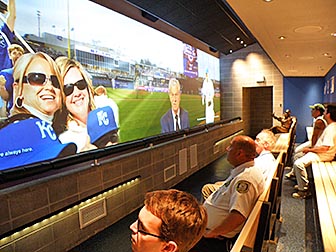  |
And just as players must walk down a tunnel to go from their clubhouse to the dugout, so do visitors to the RHOF traverse a tunnel to go from the Clubhouse entry lobby to the Dugout Theater. Here you’ll get to experience (not just watch) a 15-minute multimedia presentation on a 36-foot-wide screen (above left). I use the word “experience” because it’s not just your vision and hearing that are stimulated here. You’ll also feel the pop of fireworks and sounds from the movie thanks to devices dubbed “butt kickers” that are wired to the underneath of the benches (above right), and you’ll smell the aromas of a ballpark, like freshly mown grass and popcorn. There’s even a life-size statue of the late, great Buck O’Neil watching the movie with you inside the theater.
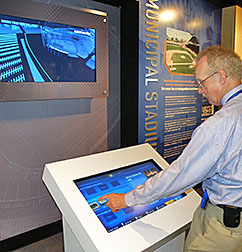 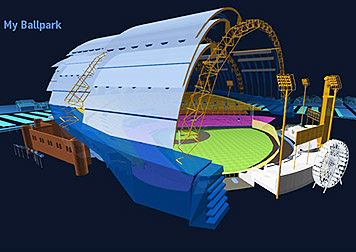 |
Once you view the movie, you enter the main exhibit area, where you can marvel at the wonderful artifacts and read the enlightening text that accompanies it all.
It won’t surprise you to learn that my very favorite part of the exhibit is the corner devoted to Kansas City’s ballparks — past and present. Of special interest here is one of the interactive components of the RHOF, where you can “build” your own ballpark (as Morrie Carlson demonstrates above left) . On a touch-screen, you select whether your park should have tall or short outfield walls, and how deep or shallow they should be. You can even elect to put a retractable roof over your stadium!
Best of all, you can have the resulting image e-mailed to you, as I did. The file that the system e-mailed to me is above right.
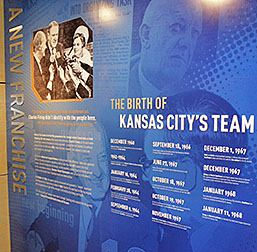 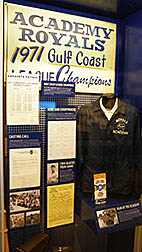 |
The exhibit space devoted to the history of the Royals franchise is particularly well done. Everything that went into the formation of this expansion franchise is well-documented, as is the groundbreaking Royals Baseball Academy (above right) that the team conducted from 1970 through 1974. By the way, do you know who the most famous graduate of that academy is? Hint: he won eight gold gloves, and there’s a corner of the RHOF devoted to him (see below).
 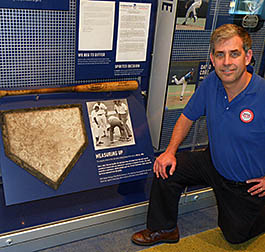 |
The RHOF building is situated so that you can look out into the ballpark’s seating bowl from part of the exhibit area. The best such vantage point features a replica of a radio booth that actually extends out from the side of the building. Here visitors can record their own play by play for noteworthy moments in the Royals’ history.
Behind you as you face the broadcast booth is a display case that contains one of the most memorable — and controversial — relics from the team’s past. In 1983, future Hall of Famer George Brett appeared to have hit a game-winning home run for the Royals against the Yankees, only to have the Yanks’ manager Billy Martin challenge the legality of Brett’s bat. Indeed, the umpires ruled that the bat had too much pine tar on it, and instead of a homer, Brett was called out, thus ending the game. The famous “pine tar bat” is shown above right, next to John Odell of Cooperstown’s Hall of Fame, who not only worked with Brett on permitting the bat to be displayed here, he also arranged for other Royals-related items to be loaned to the RHOF.
“We’re thrilled to be able to help the Royals,” John told me. “We’d love to see more museums like this. Just think how many more valuable items (of historic significance) would be preserved if every team had been collecting and exhibiting memorabilia like this.” Very true.
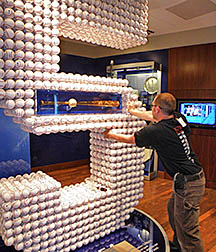  |
Speaking of George Brett, one of the most striking displays appears in the Crowning Moments room. Brett’s retired uniform number is 5, and a gigantic number 5 is made up of 3,154 baseballs — the exact number of hits he smacked during his career. Above left, the finishing touches are being put on the sculpture by a member of Dimensional Innovations, who were the fabricators (their word) who executed Populous’ design for the exhibit.
Like Brett, Frank White is another Royal whose uniform number has been retired. There’s little argument that he was one of the smoothest fielders who ever played second base, and the eight gold gloves he earned are also on display in the Crowning Moments room, as is the World Series trophy that the Royals won in 1985 (below left).
 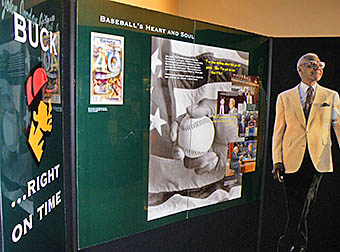 |
When Populous laid out the floorplan for the RHOF, they were quite smart to devote space to a gallery for temporary exhibits. And it’s very fitting that the first such exhibit shows items on loan from the Negro Leagues Baseball Museum, which is only a few miles from Kauffman Stadium. This is a place you certainly should visit on your trip to KC.
Most of the items on display center on Buck O’Neil (above right), whose heart and soul can be felt in the RHOF, and who was such a driving force behind the Negro Leagues Museum. As an aside, perhaps the most unfortunate aspect of Cooperstown’s Hall of Fame is that O’Neil wasn’t awarded his Lifetime Achievement Award while he was still alive to experience it. At least he is immortalized there now, because the sport never had a better ambassador than Buck.
Kauffman Stadium is, and has always been, one of America’s greatest ballparks. For years, I’ve believed that it contains the single best feature at any ballpark — namely, the fabulous fountains. With the addition of the Royals Hall Of Fame, could it be that Kauffman now holds the top two ballpark features in the land?